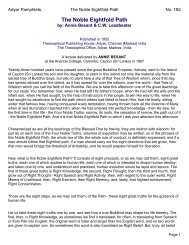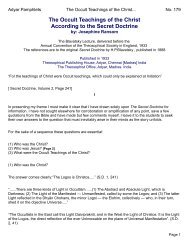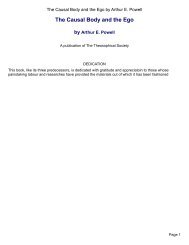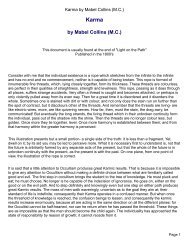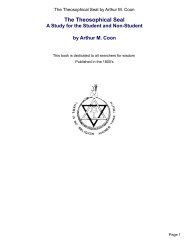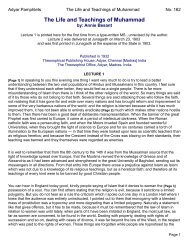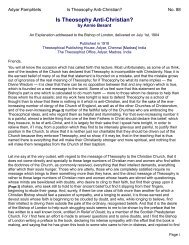The Occultism of Southern India
The Occultism of Southern India
The Occultism of Southern India
You also want an ePaper? Increase the reach of your titles
YUMPU automatically turns print PDFs into web optimized ePapers that Google loves.
<strong>The</strong>osophical Siftings <strong>The</strong> <strong>Occultism</strong> <strong>of</strong> <strong>Southern</strong> <strong>India</strong> Vol 5, No 13<br />
apostles have <strong>of</strong>ten found that their wisdom left them even in life, when their work was done; the<br />
overshadowing adept then withdrawing his inspiration this overshadowing by a high adept is what is<br />
called a divine incarnation, an avatâr.<br />
It is probable that Sankarâchârya was such an incarnation.<br />
He was already a great adept when he was sixteen years old; at which time he wrote his great<br />
philosophical works. [Page 17]<br />
It seems that Gautama Buddha was not such an incarnation, as we see in him the actual life struggle <strong>of</strong><br />
man striving to perfection, and not the fruition <strong>of</strong> a great soul who had already reached its goal. But in<br />
Sankarâchârya we see no such struggle; this is why we say he is a divine incarnation.<br />
<strong>The</strong> seven rays we have spoken <strong>of</strong> represent the outflowing energy from the seven centres <strong>of</strong> force in the<br />
Logos: represent seven forces, so to speak, which must enter into every thing in the universe. No object<br />
can exist without the presence <strong>of</strong> each <strong>of</strong> these seven forces.<br />
A man's past Karma determines which <strong>of</strong> the seven, or, practically speaking, five rays <strong>of</strong> occult wisdom<br />
he shall take his place in; but it is impossible to say that the fact <strong>of</strong> belonging to one <strong>of</strong> these rays<br />
indicates the presence in a man <strong>of</strong> any particular moral or mental quality; such as patience, honesty, or<br />
courage, on the one hand; or the poetic or artistic faculty, on the other.<br />
<strong>The</strong> <strong>Southern</strong> Occult school divides the states <strong>of</strong> consciousness into three: — (1) jagrat, or waking<br />
consciousness; (2) swapna, or dream consciousness, and (3) sushupti, or the consciousness <strong>of</strong><br />
dreamless sleep. As this classification stands, however, it is purposely obscure: to make it perfect, it must<br />
be understood that each <strong>of</strong> these three states is further divided into three states.<br />
Let us take these in their order, beginning with the lowest.<br />
<strong>The</strong> jagrat consciousness is divided into three; (1) the jagrat <strong>of</strong> jagrat, which is ordinary waking<br />
consciousness; (2) the swapna <strong>of</strong> jagrat, the ordinary dream state; (3) the sushupti <strong>of</strong> jagrat, which is<br />
dreamless sleep.<br />
Similarly, the swapna state has three divisions; (1) the jagrat <strong>of</strong> swapna, which is the consciousness <strong>of</strong><br />
waking clairvoyance; (2) the swapna <strong>of</strong> swapna, or somnambulic clairvoyance; and (3) the sushupti <strong>of</strong><br />
swapna, the consciousness <strong>of</strong> Kama Loka.<br />
<strong>The</strong> sushupti state is also divided into three states; (1) the jagrat <strong>of</strong> sushupti, the consciousness <strong>of</strong><br />
Devachan; (2) the swapna <strong>of</strong> sushupti, the consciousness in the interval between two planets; and (3)<br />
the sushupti <strong>of</strong> sushupti, the true arupa (formless) consciousness which exists between two-planetary<br />
Page 2



